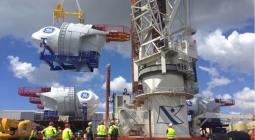Massachusetts Officials Recommend Another 1.6GW of Offshore Wind.

The Bay State should schedule several more offshore wind solicitations running into the mid-2020s, the Massachusetts Department of Energy Resources concluded.
State officials recommended that Massachusetts double down on its offshore wind program and sign contracts for another 1,600 megawatts of capacity in two solicitations to be held in the early 2020s.
The Massachusetts Department of Energy Resources released a report Friday summarizing its study into the state’s approach to offshore wind thus far, and whether it makes economic sense to sign up for more capacity.
Among the report’s recommendations:
- Massachusetts’ electric distribution companies should proceed with another 1,600 megawatts of offshore wind solicitations, as long as the contracts prove to be cost-competitive. This would come on top of the 1,600 megawatts the state is already pursuing, half of which was awarded last year to developer Vineyard Wind.
- Two 800-megawatt solicitations should be held in 2022 and 2024, following the one already planned for later this year. Another could follow in 2026 if not all the capacity has been awarded.
- While the state should continue to allow paired energy storage with offshore wind bids, it should also consider holding a standalone energy storage solicitation — in recognition of the reality that any wind-plus-storage bids will likely come in more expensive than other options, even if beneficial to the grid.
-
More than any state, Massachusetts is responsible for the burgeoning U.S. offshore wind market. Its Energy Diversity Act of 2016 directed the state’s electric distribution companies — Eversource, National Grid and Unitil — to procure 1,600 megawatts of offshore wind.
More than any state, Massachusetts is responsible for the burgeoning U.S. offshore wind market. Its Energy Diversity Act of 2016 directed the state’s electric distribution companies — Eversource, National Grid and Unitil — to procure 1,600 megawatts of offshore wind.
Vineyard Wind, a joint venture of Avangrid and Copenhagen Infrastructure Partners, won the first 800-megawatt solicitation last year with a bid that equates to an inflation-adjusted levelized cost of $65 per megawatt-hour over the project’s operating life, including the renewable energy credits (RECs).
Wood Mackenzie Power & Renewables forecasts 13 gigawatts of U.S. wind installations in the 2021-28 period, with the market rebounding rapidly after the expiration of the ITC thanks to state-level support.
The cost of offshore wind has dropped rapidly in Europe in recent years as turbines have gotten larger, and those decreases are expected to translate fairly quickly over to the U.S. market, despite the lack of a local supply chain and the red tape associated with the Jones Act.
The 30-megawatt Block Island Wind Farm, completed in 2016 and the only offshore wind farm operating in U.S. waters today, reportedly secured a power-purchase agreement starting at $244 per megawatt-hour and rising with inflation from there.
Since Massachusetts' first offshore wind solicitation last year, three more development zones have been awarded south of its coast, bringing global energy giants like Shell and Equinor into its waters — and likely intensifying the competition for future contracts.
The supply-chain derby
However, there is risk for Massachusetts in going even bigger on offshore wind, the Department of Energy Resources’ report acknowledged.
Offshore wind solicitations are likely to save ratepayers money compared to buying the same amount of clean power in the wholesale market alongside the equivalent amount of RECs, the report said. But that conclusion is highly dependent on future REC prices, which have declined in recent years thanks in part to Massachusetts’ energy-efficiency programs.
The report suggests that REC prices are likely to rise again in the years ahead as the heating and transportation sectors become increasingly electrified, but there are no guarantees.
The report points out that offshore wind prices would likely be lower if the state were to wait until the late 2020s before its next solicitations, taking advantage of the ongoing cost declines. In doing so, however, Massachusetts may lose its early edge in attracting supply-chain investment and the attendant jobs.
While New Bedford's Marine Commerce Terminal in southern Massachusetts is set to play a key role in the first wave of big U.S. projects, other states in the region, including New York, New Jersey, Connecticut and Rhode Island, are aggressively pursuing supply-chain investment.
Some in the industry believe the first round of major supply-chain announcements is coming soon, once New York and New Jersey have published the winners of their first offshore wind solicitations.
2 June 2019





